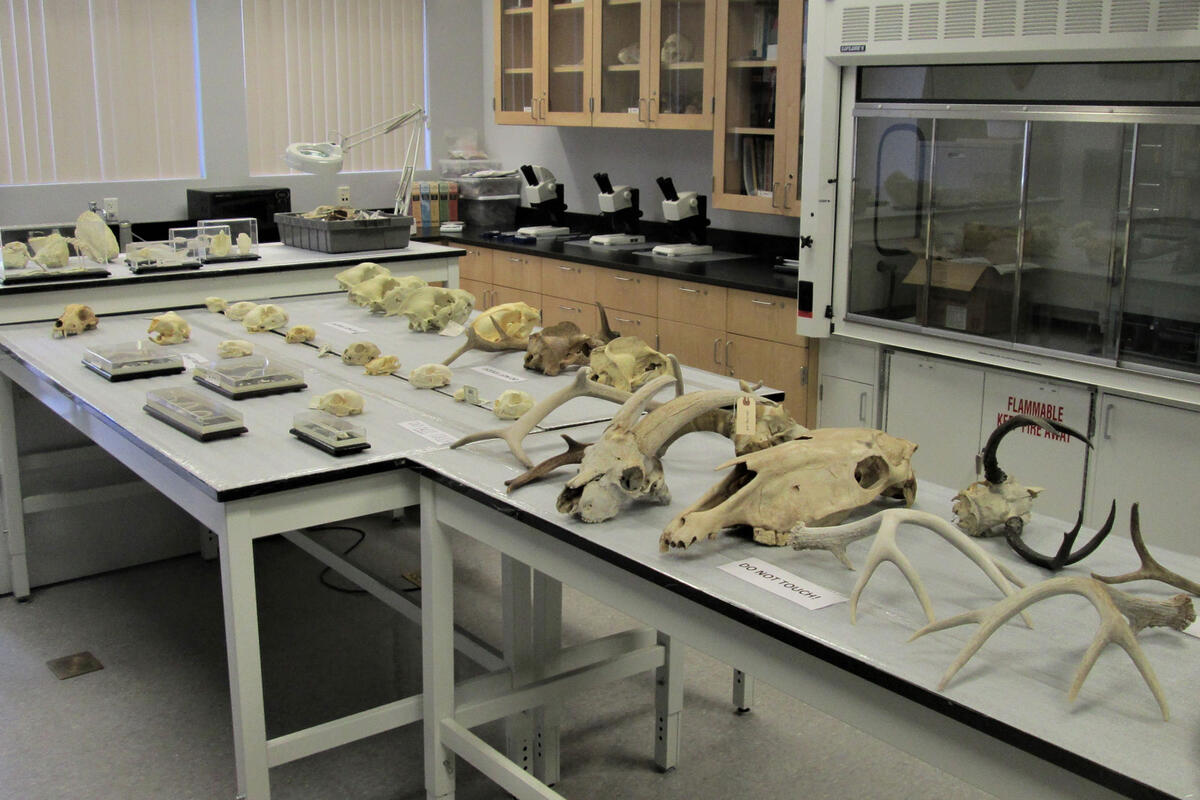
Zooarchaeology Lab
The UNLV Zooarchaeology Laboratory was established by Levent Atici in September 2008. The lab is located in Room 104 on the first floor of John S. Wright Hall - Building C. The lab offers students and researchers ample work and storage space for the analysis of archaeological animal bone assemblages from across the world. A yearly zooarchaeology laboratory course introduces the basic tenets of zooarchaeology and gives undergraduate and graduate students hands-on training and the ability to identify, document, analyze, interpret, and report archaeological animal bone assemblages. The lab also provides students a large corpus of faunal manuals, osteology atlases, books, and reprints related to zooarchaeological research.
Contact
Barbara J. Roth, Ph.D
Department Chair
Email: barbara.roth@unlv.edu

The lab is equipped with cutting-edge analytical tools including a 3-D laser scanner, a Leica digital stereo zoom microscope with photographic equipment, three Leica stereo zoom microscopes, a portable Nikon microscope, digital calipers, electronic balances, fume hood, a convection oven, two computer stations with printer, scanner, and various software platforms, carcass preparation equipment and access to wet area and sinks outside the lab.



As reliable and accurate identification of animal remains from archaeological sites depends on the availability and accessibility of a good comparative collection of modern specimens with known species, age, and sex information, it is essential for the lab to expand its collections. Such collections also facilitate teaching comparative osteology, zooarchaeological methods, and taphonomy, as well as enable students and researchers to engage in the analysis of archaeofaunal assemblages from Nevada and surrounding areas.

Currently, the modern reference collection largely contains disarticulated skeletons of wild and domestic vertebrates from southwest Asia and eastern Mediterranean. It also has many skeletons of terrestrial and marine mammals from southwestern United States.

Besides the expanding modern reference collection, excavated faunal assemblages from Körtik Tepe (a pre-pottery Neolithic site in southeast Turkey) and Kültepe (a major Assyrian Trading Colonies center in central Turkey) are currently housed in the lab for comprehensive analyses.

Conducted by Levent Atici
- Origins of the Agricultural Revolution in the SW Asia and its Spread into Europe
Ugurlu Höyük in NW Turkey and Girmeler Cave in SW Turkey
I focus on various social and economic characteristics of the Neolithic Revolution and their reflections on animal exploitation strategies. Toward this end, I explore the spread of emerging Neolithic economies with domesticated animals and plants into Europe using faunal assemblages from two early Neolithic sites, Ugurlu Hoyuyk on the Turkish island of Gökçeada in the Aegean Sea, and Girmeler Cave in the southwestern most region of Turkey.

- Zooarchaeology of Food Provisioning in Complex Societies
I probe food provisioning in ancient urban societies and seek to illuminate the social and economic characteristics of the Anatolian Bronze Age by developing a picture of the exploitation of animal resources and providing insight into the roles played by different levels of socioeconomic and political organization, such as small villages and urban centers.


- Principal zooarchaeologist, Uğurlu Höyük excavations (Gökçeada, NW Turkey)
- Principal zooarchaeologist, Girmeler Cave excavations, (Fethiye, SW Turkey)
I am very happy to supervise graduate students willing to pursue careers in anthropological archaeology with a research emphasis on zooarchaeology. I am also happy to provide qualified students with access to research facilities, fieldwork, and dissertation material in Turkey. Research topics may range from paleolithic forager adaptations to origins of farming to evolution of specialized pastoral economies in the Near East in general, and in Turkey in particular.

Virginia Lucas
Research Interests: Complex societies, Zooarchaeology, Iron Age, Romania, Southeastern and Southwestern United States; Exchange Economies; Subsistence Strategies